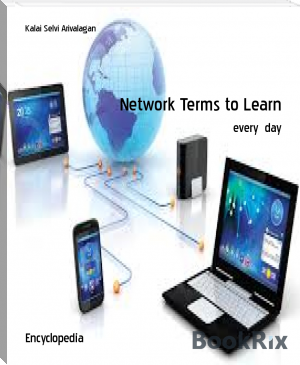Network Terms to Learn by Kalai Selvi Arivalagan (top android ebook reader TXT) 📕

Read free book «Network Terms to Learn by Kalai Selvi Arivalagan (top android ebook reader TXT) 📕» - read online or download for free at americanlibrarybooks.com
- Author: Kalai Selvi Arivalagan
Read book online «Network Terms to Learn by Kalai Selvi Arivalagan (top android ebook reader TXT) 📕». Author - Kalai Selvi Arivalagan
SaaS Sprawl (Software-as-a-Service Sprawl)
SaaS sprawl (Software-as-a-Service sprawl) is a phenomenon that occurs when the number of third-party cloud applications being used on a network reaches a point where administrators can no longer manage them effectively. SaaS sprawl typically occurs when project teams and individual users download and install cloud apps to meet an immediate work need without waiting for their IT department to review and approve the cloud vendor’s software product. The ease of procuring, deploying, and using software-as-a-service (SaaS) applications has made this type of shadow IT easier to deploy than ever before.
(Note also that Individuals can also use Cloud-based SaaS applications directly on the web without installing any software. This can lead to Data Loss Prevention (DLP) issues and place unauthorized business data outside of your normal operating environment or jurisdiction.)
COVID-19 work-from-home mandates inspired many business departments to allow the unsupervised use of cloud apps without stopping to consider how the apps would fit into the organization's workflows. Although the large majority of cloud apps are used in isolation, it’s still important for IT departments to manage the data that moves in and out of them.
Term of the day - 29
Block Reward
The bitcoin block reward is a particular rule for the bitcoin cryptocurrency. Bitcoin's developer, Satoshi Nakamoto, thought up the bitcoin reward as a way to control circulation. The bitcoin reward dictates what amount miners get for mining bitcoin.
Kubernetes
The Kubernetes container system is an open-source system for container virtualization. It is a popular part of new enterprise plans to streamline IT services and architectures, for example, the creation of microservices or new application containment systems that help companies to enhance their processes and build a “DevOps” or agile development model.
Information Systems Security Engineer
An Information Systems Security Engineer (ISSE) is the person in an organization who determines system security requirements. The ISSE also designs the security layout or architecture and determines required security tools and existing tool functionality.
Confusion Matrix
A confusion matrix is a type of table construct that plays a specific role in machine learning and related engineering. It helps to show the prediction and recall in a system where the values of the test data are known.
IronRuby
IronRuby is an open source interpretation of the Ruby programming language. It was created for Microsoft common language runtime (CLR). IronRuby was created as an open-source project, and its complete source code is released under Microsoft Public License. IronRuby runs on the .NET framework and offers several different tools and executables.
Common Language Infrastructure (CLI)
Common Language Infrastructure (CLI) is a Microsoft specification for running high-level language program applications in different computer systems without changing the application code. CLI is based on the Microsoft .NET concept that some high-level language programs require modifications due to system hardware and processing constraints. CLI compiles applications as Intermediate Language (IL), which is automatically compiled as native system code. This approach allows applications to run without code rewrites in limited systems.
True Negatives
True negatives, in machine learning, are one component of a confusion matrix that attempts to show how classifying algorithms work.
True negatives indicate that a machine learning program has been set on test data where there is an outcome termed negative that the machine has successfully predicted.
Swift
The Swift programming language is a language that Apple developed for various operating systems, including some of its smartphone operating systems, as well as desktop platforms. It's a take on Objective-C that similarly utilizes variables to store values.
Full Stack
A "full stack" in the technology world is the entire set of software products and technologies used to accomplish a particular platform for applications. This includes elements like the operating system, database software, and more. The full stack provides an easy terminology for the entire set of tools that created architecture for a pipeline in enterprise IT.
Transformation Matrix
A transformation matrix is a matrix that represents a linear transformation in linear algebra. These have specific applications to the world of computer programming and machine learning.
Biorobotics
Biorobotics is generally thought of as the process of using biological organisms as a way to develop new technologies. It's a wide field that covers various things like cybernetics and genetic engineering, and many new scientific advances are based on different kinds of biorobotics initiatives or projects with a biorobotics component.
Data Sovereignty
The principle of data sovereignty is that data belongs to the jurisdiction of the nation-state where it is originally held in binary form. Data sovereignty helps to sort out many complicated issues about digital assets or how to regulate the flow of information online.
Hyperautomation
Hyperautomation refers to techniques and methods that can automate processes in significant and profound ways. Although the term is not clearly defined, in 2020 bodies like Gartner and big companies in the tech space are defining hyperautomation as the next wave of automation or “automation 2.0.”
Term of the day - 30Logic Programming
Logic programming is a type of computer programming that is based on formal logic rules. In a sense, logic programming corresponds to the use of mathematical equations and other logical constructs to drive programming outcomes.
Disambiguation
Disambiguation is the conceptual separation of two ideas represented by the same word, a word that has the same spelling, where it is difficult to tell which meaning is being referenced. Humans and technology systems both have their own means for disambiguation and methods for interpreting and parsing inputs. Disambiguation is also known as word sense disambiguation and text disambiguation.
Layer-Wise Relevance Propagation
Layer-wise relevance propagation is a method for understanding deep neural networks that uses a particular design path to observe how the individual layers of the program work. These types of techniques help engineers to learn more about how neural networks do what they do, and they are crucial in combating the problem of "black box operation" in artificial intelligence, where technologies become so powerful and complex that it's hard for humans to understand how they produce results.
Rust Programming Language
Rust programming language is a computer language with object-oriented characteristics that's often prized as an alternative to traditional C++. While it's syntactically similar to C++, it also has its own range of features that make it a multi-paradigm programming language that's getting a lot of attention. For example, some cite a broad user base and low overhead as practical benefits of using Rust, while others point to different types of functionality, like the ability for Rust to be compiled into Web Assembly.
Kotlin
Kotlin is an open source object-oriented and functional programming language that's often suggested as an alternative to JavaScript. Some describe it as a ‘streamlined’ version of Java.
Unified Device Architecture
Compute Unified Device Architecture (CUDA) is a parallel computing architecture useful for the support of applications that require significant amounts of parallel processing.
Pegasus
Pegasus is a specific type of spyware that can track calls, read text messages and steal data from devices, as well as implement key loggers and audio capture tools. Its design is commonly attributed to the Israeli cybersecurity firm NSO Group, and surfaced in 2016.
OpenBSD
OpenBSD is a specific type of UNIX-based operating system that is an open-source alternative to proprietary licensed products. With a Berkeley Software Distribution license, OpenBSD allows for the free use of a multi-platform and portable operating system.
SuperFetch
SuperFetch is a memory management tool in some of the newer Windows operating systems beginning with Windows Vista. It helps the system to manage random access memory (RAM) and allocate it across various applications for efficient performance.
IT Risk Management
IT risk management is the application of the principles of risk management to an IT organization in order to manage the risks associated with the field. IT risk management aims to manage the risks that come with the ownership, involvement, operation, influence, adoption and use of IT as part of a larger enterprise. IT risk management is a component of a larger enterprise risk management system. This encompasses not only the risks and negative effects of service and operations that can degrade organizational value, but it also takes the potential benefits of risky ventures into account.
BERT
Bidirectional Encoder Representations from Transformers, or BERT, is a new type of natural language processing (NLP) deep learning strategy in which deep neural networks utilize bidirectional models with unsupervised language representation.
Neuralink
Neuralink is an American company using neurotechnology to research the possibility of future innovations in high-tech neurology applications. Neuralink has gained visibility as a project backed by Elon Musk, and as a ground-breaking way of looking at neurotech in general.
LIME
The acronym LIME, which stands for Local Interpretable Model-Agnostic Explanations, is a specific type of algorithm mode or technique that can help to address the black box program in machine learning. At its most basic level, LIME will seek to interpret model results for human decision-makers.
Cyberveillance
Cyberveillance refers to monitoring all of an employee's computer activity both online and offline. This is done to decrease or eliminate instances of cyberloafing, where employees use their Internet access during working hours for personal use or otherwise use their computers for personal activities.
Two-Tier ERP
A two-tiered enterprise resource planning (ERP) system is a system where the company utilizes two separate ERP platforms. This is done for various reasons and in various ways, but typically involves augmenting a legacy system with a new different system to be used at additional business locations.
Data Brokering
Data brokering refers to the practice of obtaining information on users, aggregating it, and enhancing it to provide to clients or customers. Over 4,000 data brokering companies are at work worldwide collecting and analyzing consumer data.
Nyquist's Law
Nyquist’s law is a formula which states that to accurately represent an analog signal in a digital format, two samples per cycle are sufficient. In other words, the analog signal sampling rate must be at least two times the maximum analog frequency to extract all bandwidth information and accurately represent analog signals in a digital format. Sampling rates that slightly exceed twice the suggested frequency level leads to imprecision in filters and other components used for analog to digital conversion. Nyquist’s law is also known as Nyquist’s Theorem.
Analytic Geometry
Analytic geometry is a kind of geometry using a coordinate system. The kind familiar to most people is the two-dimensional plane using the x and y-axes. Three-dimensional analytic geometry adds a z-axis. Both the 2-D and 3-D versions of analytic geometry are widely used in computer graphics to place objects on the screen. Analytic geometry is also known as Cartesian geometry or Coordinate geometry.
Semi-Supervised Learning
Semi-supervised learning is a method used to enable machines to classify both tangible and intangible objects. The objects the machines need to classify or identify could be as varied as inferring the learning patterns of students





Comments (0)